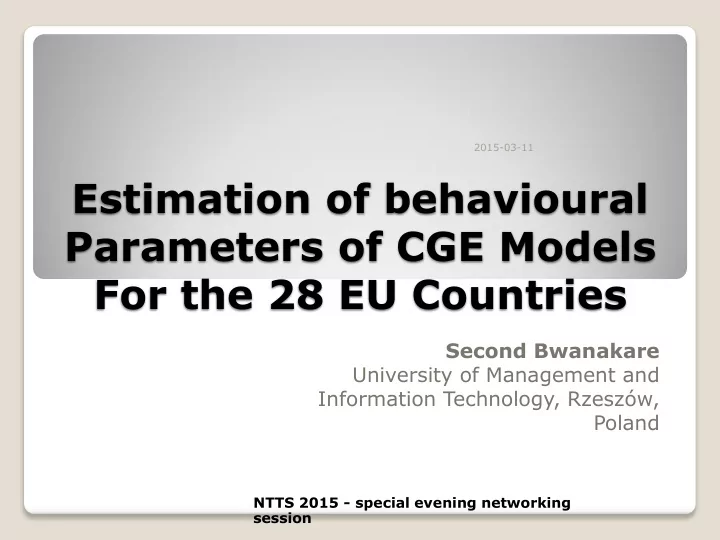

2015-03-11 Estimation of behavioural Parameters of CGE Models For the 28 EU Countries Second Bwanakare University of Management and Information Technology, Rzeszów, Poland NTTS 2015 - special evening networking session
Research project objectives Objective: Estimating industry behavioural parameters of the 28 EU countries ( period to be defined ) Time-space comparison of estimated parameters vs. macroeconomic theory (e.g., comparison of factor elasticity of substitution within similar industries and period for different countries) ===> Output consistency A higher accuracy of macroeconomic estimated model through more reliable CGE behavioural parameters ===> Better outcomes NTTS 2015 - special evening networking session 2015-03-11
METHODOLOGY Statistical data collecting and processing GAMS Code for the Non-extensive Cross- entropy Econometrics (NCEE) technique to estimate behavioural parameters (CETS, CET, Armington models) Applying the post-NCEE behavioural parameters to the existing EU CGE models Interpretation of outputs to be published. NTTS 2015 - special evening networking session 2015-03-11
METHODOLOGY Main characteristics of NCEE A Jorgenson-based econometric CGE model Connects the maximum entropy principle with the Bayesian approach Possible generalization of classical econometric (error minimizing) approaches Nevertheless, a time-consuming estimation technique, due to a difficult setting up of appropriate model optimization starting points. NTTS 2015 - special evening networking session 2015-03-11
METHODOLOGY Classical econometric approaches Competitive methods to be computed: Nonlinear least squares (NLS) approach Generalized method of moments (GMM) Maximum likelihood (ML). NTTS 2015 - special evening networking session 2015-03-11
Preliminary model outputs and concluding remarks Case study : the 27 EU country aggregated data , Germany , France , Great Britain . Outputs from the NCEE technique are stable, irrespective of the involved statistical data and the countries selected Outputs from other techniques sharply change with different data and for different periods. NLLS seems to behave better. ML outputs are worse. NTTS 2015 - special evening networking session 2015-03-11
Recommend
More recommend